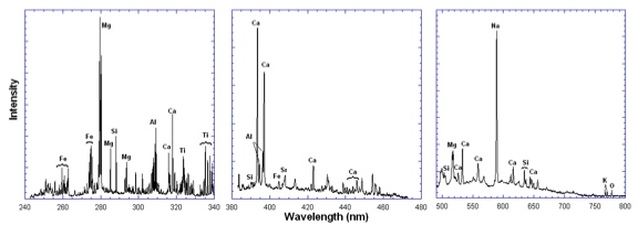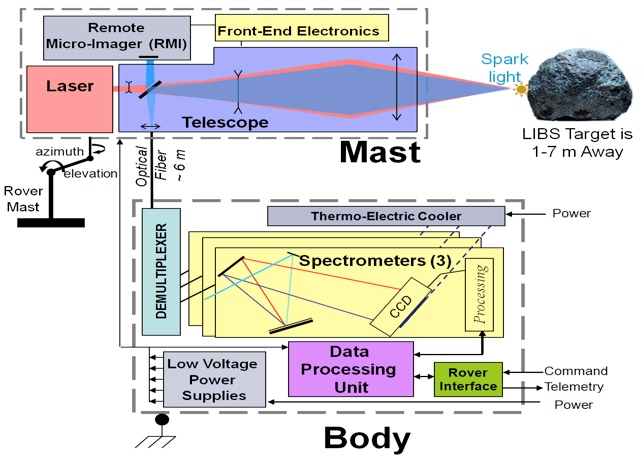ChemCam Instrument Overview
ChemCam is an instrument package that consists of two remote sensing elements – The Laser-Induced Breakdown Spectrometer (LIBS) and a Remote Micro-Imager (RMI). LIBS will provide elemental compositions of samples while the RMI puts the analyses done by LIBS into a geomorphologic context. The instruments will determine which rocks and soil areas in the rover’s vicinity are of particular interest and require further examinations with other instruments. A big advantage of this instrument package is the speed at which samples can be analyzed compared to contact and analytical MSL instruments. Local and regional soil profiles will be provided by ChemCam. Also, samples that are out of reach of all other instruments can be analyzed with ChemCam and it provides the capability of passive spectroscopy.

LIBS – Laser-Induced Breakdown Spectrometer
LIBS uses Laser Pulses that are focused on a small spot on the targeted rock/soil area. It has a range of 7 meters. A spot of 0.3 to 0.6mm is being hit with 14mJ laser pulses with a 5 nanosecond duration. When the laser beam hits atoms or ions, they are transitioning to an electronically excited state and produce photons/light emitting plasma which will then be analyzed. This emitted light is being collected in a 110mm telescope and focused onto the end of a fiber optic cable. This fiber is capable of carrying the light to all spectrometers that analyze the emitted wavelengths thus deducing soil composition. A spectra range of 240-850nm at resolutions of 0.09 to 0.3nm in 6144 channels can be analyzed. About 50 to 75 laser pulses will be fired at a single sample to achieve a desired accuracy of 10% at the maximum distance of 7m. LIBS has many advantages such as quick studies of samples without any sample preparation or contact, it has the ability of removing dust with repeated laser pulses at the same spot, it can identify water or hydrated minerals and LIBS has a very low energy consumption due to the use of efficient laser light and short analysis time.

RMI – Remote Micro Imager
RMI is a context imager for the LIBS instrument. It does not have any range restrictions and can image targets at any distance. Its purpose is to image the samples that are examined by LIBS to give scientists a chance to identify the laser spot and see its exact position. It also provides the opportunity to visually study the rocks. RMI uses the same telescope as LIBS. The detector has a 1024×1024 pixel resolution.
Science Investigations
- Rapid Remote Rock Identification (Will rapidly determine whether a given sample is similar to ones that have already been analyzed during the mission identifying samples that have yet to be analyzed by the other instruments thus providing a more efficient sampling process)
- Quantitative Elemental Analyses to support the MSL Science Objectives. Quantitative research will require a number of test spots per rock.
- Soil and pebble composition surveys. The soil around the rover will be analyzed at regular intervals to provide a profile of soil composition over larger area and note changes in elemental composition. RMI can deduce grain knowledge, so that none of the contact instruments have to be used for that aspect.
- Detection of Hydrated Minerals. LIBS and its sensitivity for Hydrogen will spot any bound water in mineral samples.
- Depth profiles of rock weathering layers. LIBS will provide weathering profiles on a fine scale.
- Remote sensing of ice/frost on the surface. Water ice can be detected by the LIBS instrument.
- Geomorphology and imaging science. RMI will provide high resolution images that enable studies of weathering processes on surfaces without the need of contact instruments and at a higher resolution than MASTCAM when imaging closeup details.
- Complement other techniques for rock/soil identification in cases of dust or weathering. Other instruments can be assisted by LIBS Laser Beams
- Assist with Sample Acquisition, Processing, and Handling (SA/SPaH) ChemCam will be used to determine which samples to study with other instruments of the Rover.
Science Techniques and Investigations
ChemCam is a very versatile instrument which can be used for different sorts of analyses.
A usual sampling sequence to rapidly identify a rock will take about 6 minutes. Thermoelectric coolers will be activated a short time before the instruments are powered up to cool down the equipment. The target is acquired by moving the mast in the correct position. Instrument turn-on follows and the LIBS laser and the autofocus laser are warmed up if needed. The telescope is automatically focused on the target. Then RMI and LIBS analyses is performed. RMI usually takes data before and after LIBS analyses. In addition to laser spectral analyses, LIBS will take a background spectrum without using the laser. When this sequence is complete, the mast can move to the next target and the imaging sequence can be repeated.
Other types of analyses that will be conducted by ChemCam:
- Depth profiles that require more than 500 laser pulses to analyze soil at a depth of more than 0.5mm
- Soil Surveys
- Quantitative Analyses, Many test spots on a single rock utilizing the sequence illustrated above
- Calibration targets: LIBS Spectra Calibration is ensured by taking data on targets with known properties mounted on the rover itself
- Imagery independent of LIBS readings. RMI can take images of items to provide a characterization of samples of other instruments, conduct general geomorphology studies and image distant items at a high resolution
- Passive UV-Visible Spectra: LIBS can take spectra readings without using laser pulses utilizing only ambient sunlight.
Components

Chem Cam is divided into the Body Unit and the Mast Unit which can be broken down into individual instruments as well. The Body Unit contains the spectrometers and the main data processing assembly as well as power supplies, coolers and interfaces to the rest of the rover (Data and Telemetry interfaces). Laser, Imager, telescope and focus laser are in the mast unit. The mast unit is located above MASTCAM and NavCam. It is located 2.1m above the ground. The 6m fiber cable connects both units. Components of ChemCam were provided by the Jet Propulsion Laboratory, CESR and LANL.
Instrument Operation/Calibration
Calibration of the LIBS Spectrometer is done preflight in laboratories using Mars analogs. After Landing on Mars, a new set of calibrations using the samples mounted on the rover will be performed. Pre-flight and Post-landing calibration results will be compared to ensure the instrument is in good shape.
Mission Operations will be shared between the USA and France to equal parts of science time. Downlink times will drive the cycle of operations. Are downlink times too late in the US day, France will operate the instrument. Are downlink windows late in the day in Europe, the US will take over and operate the instrument. Scientists from both countries will be involved in all decisions.
